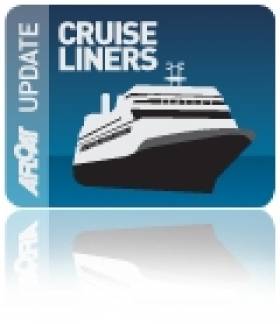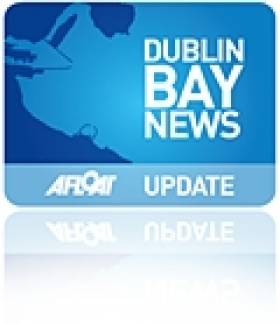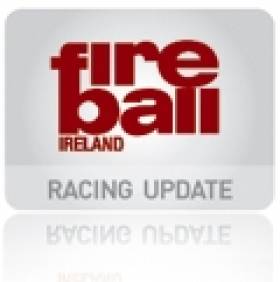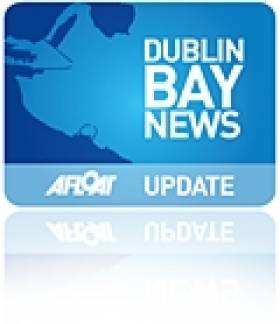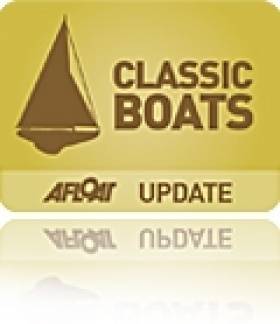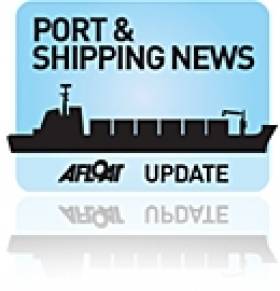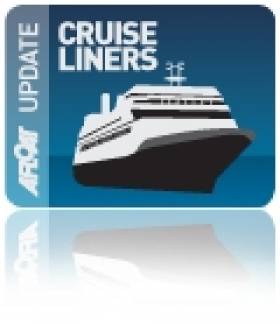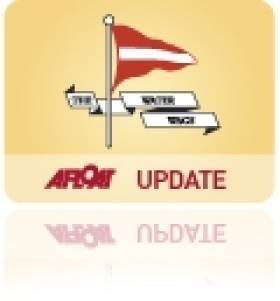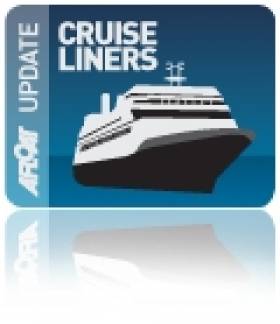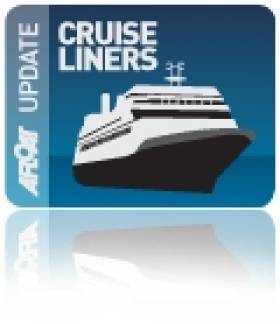Displaying items by tag: Dun Laoghaire Harbour
Businesses to Fight Dun Laoghaire Port Cruise Plans
#CruiseConcerns- An objection from businesses in Dun Laoghaire are to be lodged over the proposed development of the harbour into a cruise ship facility, reports the Herald.ie.
The Dun Laoghaire Rathdown Ratepayers' Association will make a submission outlining concerns about the Harbour Company's €15m plan to overhaul the harbour.
It will bring no economic benefit to the area and will upset the harbour, according to association chairman Peter Kerrigan.
"Passengers on cruise ships won't spend money in the town - they'll go out to Glendalough or into the city. All of their food and accommodation is on board," he said.
"With the ferries we had tourists coming in. They stayed locally and spent money."
The ferry routes were the "bread and butter" of the seaside town, Mr Kerrigan added.
Stena Line called time last month on its Dun Laoghaire-Holyhead route.
For more on the newspapers story click, here.
As previously reported on Afloat.ie, the Dun Laoghaire Harbour Company unveiled Cruise Berth Plans details of the proposed €18m plan to facilitate some of the world's biggest cruise liners inside the harbour walls.
As of today (30 March), the DLHC has opened a two week public consultation process in advance of an expected planning application to An Board Pleanala for the project.
In advance of the submission of the planning application, the Dun Laoghaire Stakeholder Group is anxious to hear the views of harbour stakeholders and the general public.
Observations or comments can be submitted to the Dun Laoghaire Harbour Company, anytime up to 5pm on Friday, 13th April 2015.
For full details of the proposals and the public consulation process visit: http://dlharbour.ie/projects/cruise-berth-consultation/
Strong Winds Cancel Dublin Bay Spring Chicken & DMYC Frostbite Series
#dbsc – Although Kinsale's natural harbour may have provided the necessary protection for the penultimate round of the south coast town's Frostbite series yesterday, there was no such shelter from the winds on the east coast with both of Sunday's Dublin Bay sailing fixures cancelled. DBSC's cruiser Spring Chicken organisers were forced to cancel in the morning and the DMYC dinghy frostbite series followed suit yesterday afternoon as gusts hit 40–knots off Dun Laoghaire harbour.
Fireball Dinghy Racing 'Gladdens The Heart' in Dun Laoghaire Harbour
#dmycfrostbites – In the presence of an unusual large high pressure over Ireland, the Fireball frostbites were greeted by a lovely 10-15kt breeze from the west, cool as it was, the warmth of the sunshine kept sailors moving for races 11 and 12 of the DMYC Frostbite series. The race committee laid a Trapezoid course inside the Harbour walls with a windward mark laid well away from the West Pier giving clear breeze all the way from the start line to the mark. With a congested start line due to a highly favoured committee boat all boats got away cleanly. Initially most of the fleet kept on starboard tack out toward the middle of the harbour, Noel Butler and Stephen Oram 15061 peeled off first to the right hand side with Kenneth Rumball and Ed Butler following suit leaving the Clancy brothers 15113 to head out to the left of the beat.
At the top mark the Clancy brothers came out on top followed by Rumball/Butler... The two boats played cat and mouse with Rumball/Butler overtaking on the next beat and holding on to their lead to take the win. A bit further back there was great racing throughout the fleet. Alistair Court and crew Gordon snapped at the leaders heels and narrowly missed third place in not one but both races. Neil Colin/Margaret Casey diced with Frank Miller/James Murphy and Louis Smyth/Glenn Fischer. Colin's light air credentials paid dividends in race one when he went hard right against many odds and came out ahead. Most of the fleet favoured working their way towards the left hand layline where a tad more pressure and a lift to the windward mark delivered rewards. Further back Mary Chambers and Brenda McGuire tussled with Louise McKenna sailing with Edward Coyne. The latter, and his family, deserves a medal for his epic journey from Youghal to make the start, with dense fog for most of the journey adding a distinct frisson of uncertainty all the way to Dun Laoghaire.
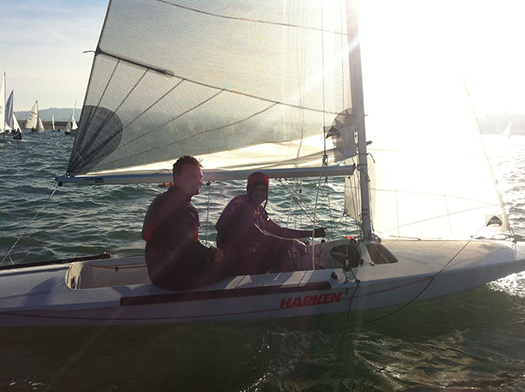
With the days getting longer, there was time for a second race, in very welcome increased pressure with full trapezing on the beats. A congested committee boat end saw Rumball/Butler and Butler/Oram getting away cleanly with a disagreement between the Clancy brothers and Colin/Casey at the committee boat. Rumball/Butler managed to tack clear of Butler/Oram to round the weather mark first and hold the lead to the finish of the three lap course. Not a huge amount of change further back though Miller/Murphy and Smyth/Fischer managed to squeeze ahead of Colin/Casey with Court/Syne having to settle again for a leather medal 4th.
In summary this was the kind of sailing day to gladden the heart, especially for February and the prospect of longer days ahead should surely entice out any remaining stragglers.
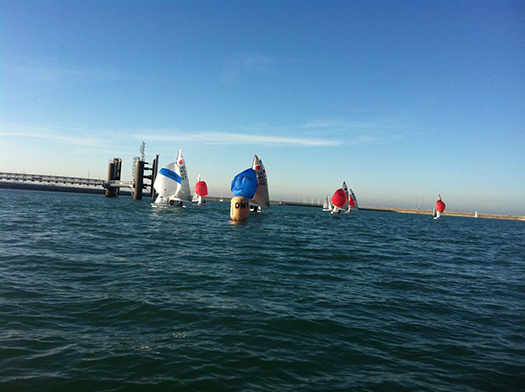
Santa Claus is Coming to Dun Laoghaire Harbour
#santa – Dún Laoghaire Harbour will be transformed into a winter wonderland this Christmas, say the Harbour company. A programme of 'magical' events is taking place at the harbour from 26th November until 23rd December 2014.
Families are invited to get into the Christmas spirit by attending many of the events this festival has lined up at the harbour.
Santa Claus is coming to Town
What could make Christmas more enchanting than meeting Santa Claus himself? Enjoy an unforgettable line up of entertainment as Christmas celebrations kick off with Santa Claus's arrival at 5.30pm on Saturday, 29th November at Harbour Plaza.
Then the Christmas lights will be switched on and a breath-taking fireworks display over Dún Laoghaire Harbour will officially announce that Christmas in Dún Laoghaire is underway.
Magical Christmas Lantern Procession
The magical lantern procession will see children of all ages light up the street from the People's Park to the East Pier on Saturday, 20th December at 4pm. The handmade willow and tissue paper lanterns come in all Christmas shapes and sizes.
The procession, led by a group of drummers, will take the following route: Park Road; Upr. Georges Street; Marine Road; Queens Road; and the East Pier. It will be followed by a spectacular Fireworks display from the East Pier Lighthouse at 5pm
Glen Keelboat Class Fleet Celebrate Fifty Years of Sailing
#glensailing – The Glens are celebrating 50 years sailing and racing together as a class in Dublin Bay Sailing Club, writes 'Glenshane' skipper Pete Hogan. As a very successful season draws to a close for the 12 or so Glens in Dublin Bay there seems all prospects that the fleet can continue for a further 50 years.
The story of the Glens is worth repeating. Designed by the celebrated Scottish Marine architect Alfred Milne in 1945 the Glens were built by the Bangor boatyard over the following 20 years. Possibly 39 Glens, at least, were built which gives them claim to be Milne's most successful design and also one of the last of Alfred Milne Senior's designs. The firm still exists. He also designed the Dublin Bay 21's and the 24's which were recently in the news on Afloat.ie
At first the Glens were confined to the North but started appearing in Dublin over 50 years ago. Glenluce G67 celebrated last year being 50 years in the sole ownership of the O'Connor family. They started racing together as a class under DBSC organisation in 1964 and have been racing ever since.
Glens are classic little yachts, retaining their looks up to today as reminders of what sailing boats looked like before the era of plastic mouldings, high freeboards and self-draining cockpits. 25 ft. long with a full keel and sensible sail plan they represent state of the art pocket cruisers of the period.
Glens were often compared to Dragons. They are heavier, shorter and carry a bit more sail. But they were never allowed to become the development class which the Dragons became and never made the seismic shift into fibreglass construction. Their handy size however, has allowed them to survive just as the 17's in Howth survive and thrive. There is a mini wooden boat building fraternity centred on the Glens and their needs. The Brennan boatbuilding family in Dun Laoghaire, all three generations of it, being its mainstay.
Moored out in front of the Royal St George YC and each painted a distinctive different colour, the Glens have become as iconic a fixture in Dun Laoghaire as the bandstand, Teddy's ice cream shop or the fishermen casting their lines from the pier. Long may they continue.
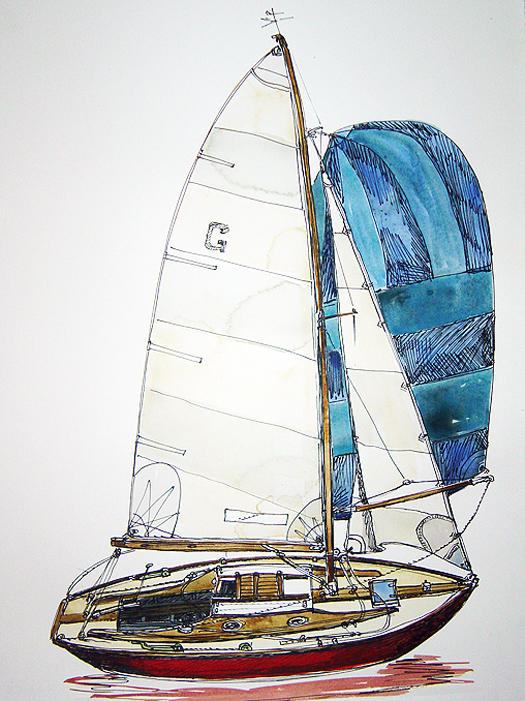
The Glen keelboat. Illustration by Pete Hogan
Anyone interested in getting involved in the Glen Class in Dublin could contact Pete on 087 930 9559 or click HERE
Guinness ‘Made of More’ Tanks Make Another Appearance
#GuinnessTanks - The current Guinness TV advert campaign 'Made of More' is apt given additional fermentation tanks bound for St. James Gate Brewery in central Dublin, arrived by cargoship to Dun Laoghaire Harbour late last month, writes Jehan Ashmore.
To recap, Diageo began last year a €153m upgrade to refurbish the historic city-centre brewery, however due to low-bridge heights restrictions, this led to use of alternative roads to transport the cylinder-shaped tanks from Dun Laoghaire Harbour instead of Dublin Port.
This latest batch of stainless steel fermentation tanks on board Wilson Goole (1995/2,446grt) are understood to each weigh up to 30 tonnes. The previous 'project' cargo unloaded in Dun Laoghaire was during late 2013 and was tasked to Thamesteel I (1989/1,984grt) see report HERE, which features a telescopic wheelhouse and she departed directly from Rotterdam.
On this occasion, Wilson Goole also departed the Dutch port but her route included en route call to Follafoss, Norway followed by a short-cut through Scotland involving a transit of the Caledonian Canal. Upon arrival to Dun Laoghaire she docked at the Carlisle Pier.
The Norwegian operated vessel also features a telescopic bridge which overlooked four of the six cylinder tanks mounted as deck-cargo while the remaining two were stowed in the hull. For drawings of the vessel's cargo-hold layout, click here.
The majority of the project's tanks where handled in 2013 during a spate of deliveries to Dun Laoghaire Harbour in which three shipments docked between mid-February to late March.
In that timeframe, Blue Tune (2010/3,845grt), Keizersborg (1996/6,142grt) and Myrte (2008/6,120grt) also berthed at the Carlisle Pier. Following unloading of the tanks, their final leg of the journey to reach the brewery involved night-time convoy operations to minimise disruption and avoid traffic congestion.
Blue Tune's call in 2013, represented the return of cargoship trading activity after an absence in the harbour of more than two decades.
At the moment the port has no other commercial customers, until Stena Line as previously reported resume sailings over the festive and new year periods.
Seabourn's 'Legend' Makes Final Cruise to Ireland & UK
#Seabourn/Windstar – Seabourn Cruises ulta-luxury Seabourn Legend that called to Dun Laoghaire Harbour yesterday, is making her final cruise to Irish and UK ports before her transfer to Windstar Cruises next year, writes Jehan Ashmore.
Her sale along with a pair of sisters to Windstar Cruises, will see the intimate 212 guest superyacht-like vessel renamed Star Legend enter service in April 2015.
By coincidence, the fourth and final caller to Dun Laoghaire this season will be Windstar Cruises sail-assisted five-mast cruiseship, Wind Surf which is due to visit this week. She has become the harbour's most frequent caller since the Dun Laoghaire Harbour Company re-launched in promoting the cruise business in 2011.
Returning to Seabourn Legend and under the command of Captain Dvergastein, the 9,975 tonnes vessel took a pilot before entering the embracing harbour arms of Dun Laoghaire (see previous report). She is on a 15 day 'Route of Britannia' cruise which had departed from the Pool of London, from where the 134m vessel transited through Tower Bridge.
She had visited St. Mary's, Scilly, and as previously reported on Afloat.ie, Waterford City Quays, marking an historic record-breaking total of three callers visiting on the one day. Today, she is in Belfast, where she is reunited with Hamburg which too had formed the trio meeting in the south-eastern city along with Silver Cloud.
The Seabourn Legend has an almost full occupancy booked for this cruise and this evening she is bound for ports along the western isles of Scotland and also a call to Greenock.
Following her Clydeside call, she is to return through the Irish Sea with further calls to the Isle of Man, France and Belgium before terminating her cruise back in London.
As to be expected with an upmarket cruise operator, Seabourn Cruises offers a very high standard in cuisine. They are a member of the Chaîne des Rôtisseurs, one of the world's most prestigious gastronomic societies devoted to fine dining, in which The Restaurent on Deck 3 is the place to be.
Among the other facilities there is the Veranda Café Lounge and nearby outdoor pool plus a pair of whirlpools. Also on that deck is the beauty salon, spa and gym. There is The Club bar and piano lounge, Casino, Show Lounge, Library / Video, Boutique and Card room.
As for accommodation, there are six categories of suites, in which there are a pair of owner's suites (54sq m) located on Deck 6. Features include living room with semi-circular couch, ocean view, dining area, forward-facing private veranda, bedroom with one queen size bed only, a walk-in closet and alcove closet. There is a bathroom with tub, shower and vanity plus a guest bath.
In addition the Owner Suites come equipped with two flat-screen TVs with DVD players, Bose Wave CD stereo system and there is complimentary Wi-Fi / internet service.
Classic Wooden Boats Get Strong Support in Dun Laoghaire Harbour
#waterwags – With a fine breeze from the west of about seven knots off Dun Laoghaire, the Water Wag Race Committee decided to hold two races, each consisting of two laps of the harbour and a final beat, on a windward-leeward course. The races were part of a short series of three evenings for the Sri Lanka Tankard (Division 1A), The Sri Lanks Mug (Division 1B), and the Meldon Cup (Division 2.)
Twenty four Water Wags showed up at the start line. This number is equal to the largest Water Wag turn out of the 2014 season and exceeds the number in the Dublin Bay Sailing Club dinghy fleet on the previous Tuesday evening, which consisted of five Fireballs, five IDRA14s, four Lasers, three Dublin Bay Mermaids, two RS400s, one OK, and one other boat. A total of 21 dinghies.
In the first Water Wag race, with a tight starting line and a short first beat, the favoured course was close to the ferry terminal, and Moosmie led the fleet initially by taking this route.
Race 1 Results:
Div. 1A. Mollie Cathy MacAleavey & Con Murphy. (husband and wife.)
Div. 1B. Marie Louise, John Magner.
Div. 2. Kate & Guy O'Leary. (mother and son.)
In race 2, using the experience of the previous race, the leading Water Wags believing that the ferry terminal side of the harbour was favoured followed each other like sheep, however, on the final lap Swift taking a risk and took the option of the harbour mouth side jumped 3 places to take the gun.,
Race 2 Results:
Div. 1A. Swift, Guy & Jackie Kilroy. (husband and wife.)
Div. 1B. Marie Louise, John Magner.
Div. 2. Kate & Guy O'Leary.
#LargestUKliner - In a major coup for Dun Laoghaire Harbour Company, the largest ever cruiseship built exclusively for the UK market, P&O Cruises 143,000 tonnes newbuild Britannia, is to visit in her first season in 2015, writes Jehan Ashmore.
Britannia is due for delivery in Spring and is to make her first call to Dun Laoghaire in mid-July.
The giant five-star luxury cruiseship with a 3,600 passenger capacity and more than 1,700 crew, is one of a record 22 cruise callers to visit Dun Laoghaire.
The significant increase in cruise calls is clear, as only four calls are scheduled this year, the most recent been the distinctive five-mast cruiseship-yacht Wind Surf which called at the weekend.
The port's developing cruise industry business, expects to deliver 100,000 cruiseship visitors and crew generating a boost to the local economy and hinterland in 2015.
To secure the ports long-term viability over the next 10-15 years, the Dun Laoghaire Harbour Company's Masterplan adopted in 2011 includes several large scale projects, among them plans for a dedicated new cruise-berth costing €15m.
Such a facility would be capable of berthing the 'next generation' of very large cruiseships within the harbour.
In the meantime the majority of larger ships have to anchor offshore and bring passengers ashore by tenders. This is time-consuming process for cruise operators and subjected to weather conditions.
The cruise industry is a key area of development of the 'regional' port which in recent years has seen a decline in Stena Line's HSS fast-ferry services to Holyhead. This season is the fourth consecutive year of the summer-only operated route.
Cruiseship-Yacht Makes Return Visit to Dun Laoghaire Harbour
#CruiseYacht- Cruiseship-yacht Wind Surf (14,000 tonnes) with her impressive five 164-ft masts docked today in Dun Laoghaire Harbour and during the port's third cruise season, writes Jehan Ashmore.
The flagship of Windstar Cruises five-strong fleet as reported yesterday has a capacity for 310 guests and towering above her passenger decks are the masts that set seven triangular shaped computer controlled self-furling sails that total 26,000 sq m.
She sailed overnight from an anchorage call off Dunmore East and her visit to Dun Laoghaire Harbour is a fly-cruise turnaround, likewise to her two previous calls last year.
On that final visit last July during the 'heatwave', as she departed her sails were furled -out (click link for photo) which was an added bonus to those strolling the harbour piers.
Wind Surf relies mostly on engine power (hence the funnel between the second and third masts), has four Wartsila diesel-electric generating sets and a pair of electrical propulsion motors that deliver 12 knots. This can be increased by combining her sails to achieve 15 knots with a favourable wind. During joint-power operations she has a sea-water hydraulic ballast system to limit heel when sailing.
As to be expected the 187m flagship has luxurious amenities and a crew of almost 200 on board the vessel that was launched as Club Med 1 a quarter-century ago for original owners Club Med. She was last extensively renovated in 2012. Her sister was in Irish waters this week when Club Med 2 called to Cobh.
Both vessels throughout their careers have cruised mostly in the Mediterranean and Caribbean, however last year was a first for operators Wind Star and Club Med to visit Irish ports. This evening she may or not 'self-furl' her sails, but will certainly motor out of the harbour bound for Douglas, Isle of Man.


























